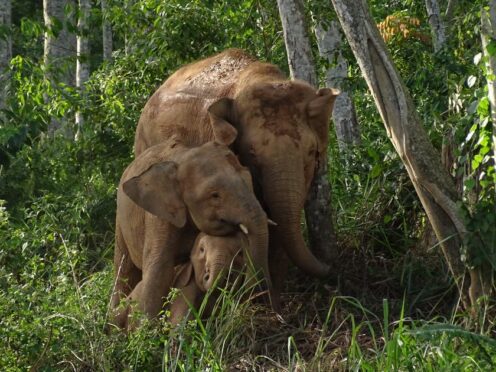The Bornean elephant has been classed as endangered, with just 1,000 animals left in the wild, the latest assessment of threatened species has warned.
The latest update to the International Union for Conservation of Nature (IUCN) Red List of threatened species also says reptile species on Gran Canaria and Ibiza are at risk of extinction because of invasive snakes.
And more than four fifths of ornamental Copiapoa cacti are now at risk of extinction, as the fashion for the plants from Chile drives an increase in the illegal trade, and climate change alters their habitat, the IUCN said.
Overall, some 45,321 of Earth’s species on the Red List – more than a quarter of the 163,040 animals, plants and fungi assessed – are considered to be at risk of extinction, either critically endangered, endangered or vulnerable, while nearly 1,000 have become extinct or are extinct in the wild.
Dr Grethel Aguilar, IUCN director-general said: “As today’s Red List update shows, biodiversity faces increasing pressures, from poaching, to climate change, to the spread of invasive species.
“Fortunately, the Red List also points to solutions. With sustained, collaborative, science-based conservation action at a sufficient scale, we can pull species back from the brink of extinction.”
The first assessment of the Asian elephant in Borneo as a distinct subspecies found there are an estimated 1,000 animals left in the wild, with the population falling over the past 75 years.
The Bornean elephant was initially hit by extensive logging of the Asian island’s forests, destroying the majority of its habitat, the conservationists said.
The expansion of the human population in the Malaysian state of Sabah, in the northern part of Borneo, has seen elephants coming more into contact with people, causing damage to crops and facing retribution killings.
Further habitat loss from palm oil and other agriculture, timber plantations, mining and development such as the pan-Borneo highway, along with poaching for ivory, vehicle collisions and the accidental ingestion of agricultural chemicals also threaten the future of the elephants, IUCN said.

There have also been major declines of reptile species because of invasive snakes on Gran Canaria, the Red List update shows.
The Gran Canaria giant lizard has been moved from least concern to the most at-risk category of critically endangered on the list, and the Grand Canaria skink has been moved from least concern to endangered, with populations of both more than halving since 2014.
They are both preyed on by the invasive California kingsnake, introduced to the island in 1998.
But there is some better news in the Canary Islands for the La Gomera giant lizard, which was driven almost to extinction by invasive cats, rats and hunting by people over several centuries, with conservation work boosting the population and seeing it move from critically endangered to endangered.
The species, which is found only on the island of La Gomera, is still highly threatened by feral cats, as well as landslides which are likely to become more frequent with climate change, the IUCN warned.
In the Balearic Islands, another native lizard – the Ibiza wall lizard – has moved from near threatened to endangered, as its population has declined by half since 2010 thanks to the invasive horseshoe whip snake.

The IUCN also warned that 82% of Copiapoa cacti are now at risk of extinction, up from 55% in 2013.
The cacti, which are found only in the Atacama coastal desert in Chile, have become popular as ornamental species in Asia and Europe, which has driven the illegal trade in the plants, helped by social media.
The development of roads and housing has brought more people into the area, making the cacti more accessible to poachers and destroying their habitat, conservationists said.
And climate change threatens their future, as the oceanic fog they need for water moves with global temperature changes, and they cannot keep up.
The IUCN said collaboration between countries was key to stopping plants being smuggled across borders, while cultivating the cacti in greenhouses could supply markets with a sustainable alternative.
Pablo Guerrero, member of the IUCN’s cactus and succulent plant specialist group said: “It is easy to distinguish if Copiapoa cacti have been poached or grown in a greenhouse.
“Poached Copiapoa have a grey tone and are coated in a dusty-looking bloom that protects the plants in one of the driest deserts on Earth, whereas cultivated plants appear greener,” he said.
